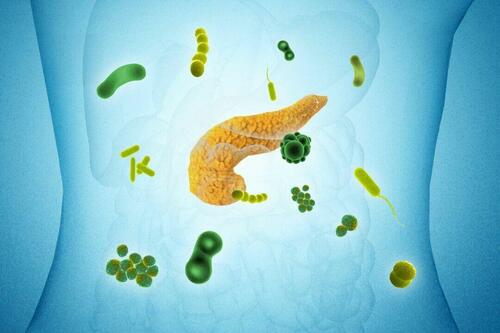Authored by Rachel Ann T. Melegrito via The Epoch Times (emphasis ours),
A simple saliva test could one day predict your risk of pancreatic cancer. Scientists have discovered that having a certain community of bacteria in your mouth can triple the likelihood of developing one of the deadliest forms of cancer—and the culprits include the same microbes that cause gum disease.

The recent study, published in JAMA Oncology, analyzed saliva samples from 122,000 participants in two large epidemiological studies and followed them for approximately nine years. During that time, 445 people developed pancreatic cancer.
In a microbiome-wide scan, researchers found 21 bacterial species linked to pancreatic cancer—eight tied to lower risk and 13 to higher risk.
In a separate test, researchers created a tool that predicted a person’s risks for pancreatic cancer. The tool took into account 27 microbes in total and would give participants a risk score depending on the microbes in their mouth. Each one-unit rise in the score tripled the risk of developing pancreatic cancer.
While some microbes in the risk score are individually linked to lower risk, the score reflects their combined effect. It’s a weighted measure that accounts for both protective and harmful species.
Three were well-known periodontal pathogens with established roles in gum disease.
The fungi implicated were Candida tropicalis, Candida spp (unresolved species), Candida albicans, and Malassezia globosa. The entire genus Candida, a common yeast, was also tied to greater risk, particularly among participants with a history of smoking.
How Mouth Bacteria Reach the Pancreas
Harmful bacteria don’t just stay in the mouth, they can travel throughout the body and trigger disease.
The mouth has local, systemic, and direct influence on disease in your body, Thaddeus Connelly, an oral and maxillofacial surgeon, physician, and CEO of Gengyve, told The Epoch Times.
“Oral microbes exist in a balanced ecosystem when we’re healthy,” said Dileep Sharma, a professor and head of discipline, oral health at the University of Newcastle. When that balance is disrupted, harmful bacteria can directly damage the gums and bone and cause chronic inflammation, first in the mouth, and later in distant organs.
“If you are chronically, or over a long period of time, constantly releasing the inflammatory molecules into your bloodstream, the tissues and organs that receive that constant alarm signal develop disease,” Connelly said. This chronic inflammation, he added, is a key driver of conditions such as heart disease, diabetes, fatty liver disease, stroke, and cancer.
Bacteria can also travel from the saliva through the gut to organs and cause inflammation and damage there, like the pancreas, possibly leading to cancer.
Poor oral hygiene and gum disease can create a steady “drip” of bacteria into the blood. Inflamed gums allow microbes to slip into tiny blood vessels during everyday actions like chewing, brushing, or flossing.
The Same Bacteria, Multiple Diseases
The same microbes associated with increased risk of pancreatic cancer are also linked to other conditions.
P. gingivalis, the main bacterium behind gum disease, has been linked to infective endocarditis, cardiovascular disease, arthritis (often in combination with Prevotella intermedia), and even Alzheimer’s disease. Prevotella species themselves have also been connected to head and neck cancers.
Fusobacterium nucleatum is implicated in the development of inflammatory bowel disease. Parvimonas species are frequently found in spinal infections. Meanwhile, Candida albicans, a common fungal organism, has been linked to an increased risk of several cancers.
According to Sharma, microbial byproducts can contribute to oral and gastrointestinal cancers, while chronic inflammation from an imbalanced microbiome may drive mutations that lead to tumors.
“It starts in the mouth and gut, with poor diet and periodontal disease to blame,” Connelly said.
What You Can Do
While the study identifies risk factors rather than proving cause and effect, maintaining good oral hygiene remains crucial for overall health.
“It is clearer than ever that brushing and flossing your teeth may not only help prevent periodontal disease but may also protect against cancer,” study co-senior author Dr. Richard Hayes, a professor in the Department of Population Health at NYU Grossman School of Medicine, said in a press release.
Most oral hygiene comes down to keeping your mouth clean and maintaining the right balance of bacteria. The basics, brushing and flossing, work by mechanically disrupting and preventing plaque from forming.
Plaque begins soft, but as it absorbs minerals, it hardens and attracts more dangerous bacterial species. Mature plaque becomes a breeding ground for harmful bacteria like F. nucleatum and P. gingivalis, Connelly said.
“Oral hygiene is critical in maintaining a clean mouth and the right bacteria in your mouth,” Connelly said. Brushing, flossing, and rinsing help stop plaque from forming and hardening into what he calls a “bad bacteria factory,” creating an environment where healthy bacteria can thrive.
However, not all oral hygiene products kill bacteria.
Toothpaste does not kill bacteria, and mouthwashes kill both good and bad bacteria, Connelly said.
“Beyond brushing and flossing, use a product that is scientifically formulated as a physical barrier against the establishment and maturation of plaque, ” Connelly said. He suggests mouthwashes that have hyaluronic acid and other mucoadhesive components such as pullulan and polyvinylpyrrolidone.
These products mix and form a protective net on the surface of the teeth and soft tissues inside the mouth, where the battle between different microbes is waged.
Research also shows that tongue cleaning supports a healthier balance of microbes.
Sharma said that lifestyle has a big impact on the oral microbiome.
Eating more fiber-rich foods and quitting smoking can improve its balance. Smoking encourages harmful bacteria tied to gum disease, while diets high in polyphenols, omega-3s, and fiber support healthy bacteria and reduce inflammation.
Other practical strategies to promote a healthy oral microbiome include:
As researchers continue to find out more about the connections between oral bacteria and systemic disease, one message is clear: Taking care of your mouth may protect far more than your teeth and gums.
Loading recommendations…

















